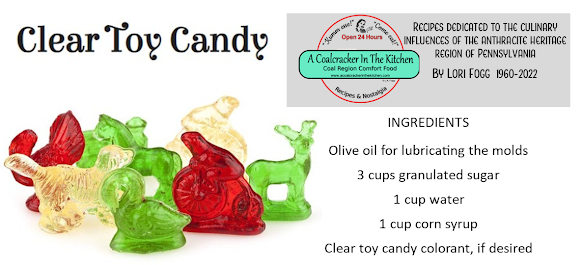Find a full version of this recipe, with instructions, at the bottom of the page
On Christmas Eve, children of Pennsylvania Dutch families would leave a plate on the table hoping that it would be filled with nuts, an apple or an orange, and clear toy candy.
Toys were scarce for children of poor families, but how practical it was to have a toy you can eat! The children would play with them as toys, wash them off and eat them.
“Clear Toy” or “Barley Sugar”?
The names clear toy candy and barley sugar are sometimes used interchangeably to refer to clear molded sugar candy. However traditional “barley sugar” is actually made with barley water in addition to cane sugar, while modern clear toy candy is made with pure water. Confusion arises because the older term “barley sugar” became generalized and was applied to a wide range of boiled sugar candies during the 1800’s.
The candies were traditionally made in three colors: clear, red and green, and were known as “the trinity”. The natural color of the syrup is yellow, which results in the “clear” version. If you want to make the candies red or green, food coloring must be added to the syrup while it is cooking.
It’s a Pennsylvania Thing
Clear toys are often not found outside Pennsylvania. The first molds to make clear toys were brought to this country by German immigrants to the Philadelphia, Pennsylvania area of North America before 1850. An active candy-making industry grew up around Philadelphia because it was a center for the sugar trade
Clear toys are made to resemble anything from a rabbit to a train car. The hot solution is poured into a mold made of iron or composition (a mixture of tin and zinc) and then quickly hardened. These molds are essential in the candy-making process. In fact, three dimensional clear toys could not be made without them.
Simple Yet Delicious
The most often used recipe is simple; a solution of corn syrup, sugar, water and, if desired, food coloring. Some makers now add flavors, but if you want the traditional taste that so many of us grew up with and associate with clear toy candy, leave added flavors out — the taste of clear toys is based on the very simple ingredients (which some people describe as akin to cotton candy). In the original 1800’s recipe cream of tartar was used along with barley water and sugar because at that time corn syrup had not been developed.
Unless you have a controlled environment, the candy can usually only be made around Christmas/winter in our area because humidity can affect the end result in hardness and clarity.
Modern-molded candy is flat while the older molds and reproductions produce 3-dimension animals, baskets, pitchers, cups, saucers and teapots. Silicone molds are available now, but the candy is not as clear as with the metal according to experienced clear toy makers. If kept cool and away from humidity, the candy has been known to remain good for up to 20 years.
A copper pot is preferred because it conducts the heat more evenly. A candy pot has a pouring spout. Pewter pots were used, and since the 1850s cast iron was popular.
Equipment for making clear toy candy
A saucepan with a pour spout makes cooking the candy syrup then filling the molds much easier. You can use a basic sauce pan or get serious with a copper candy-making pot.
A clip on candy thermometer is a must.
You can find antique clear candy molds on eBay, Etsy, at flea markets, yard and garage sales and antique markets and shops .
The antique metal molds can be expensive, but the investment is worth it if you want to produce your own candy. You can also use molds specifically for hard candy/lollipops that can be found at candy making supply shops, but these will produce flat-backed candies, unlike many of the the traditional full 3-D metal molds. Do not use plastic chocolate candy molds – these cannot stand up to the extremely high temperature of the molten sugar syrup.
If you have no molds, don’t fret; simply oil a metal cake pan and pour in the syrup to the depth of about 1/4 inch. Score the surface with a sharp knife as it hardens so it will break into bite-sized pieces.
Although you cannot control the schedule of /mother Nature, your adventures in clear toy candy making benefit when done on a cool, dry day."
==============
What is a “Coalcracker” and what the heck are you doing in the kitchen?
“Coalcracker“: Affectionate term for a resident of Northeastern Pennsylvania, but particularly of the Anthracite (coal) Region (Scranton to the Lehigh Valley to Schuylkill County).
With the expansion of the mining and railroad industries. English, Welsh, Irish and German (the “Dutch” (Deutsch) in Pennsylvania Dutch) immigrants formed a large portion of the population, followed by Polish, Slovak, Ruthenian, Ukrainian, Hungarian, Italian, Russian and Lithuanian immigrants.
The influence of these immigrant populations is still strongly felt in the region, with various towns possessing pronounced ethnic characters and cuisine. Throw in some influence from the Pennsylvania Dutch of the Schuylkill County and Lehigh Valley areas and you have a sampling of Coal Region comfort foods!
The Coal Region is a historically important Anthracite (“hard coal”) coal-mining area in Northeastern Pennsylvania in the central Appalachian Mountains, comprising Lackawanna, Luzerne, Columbia, Carbon, Schuylkill, Northumberland, and the extreme northeast corner of Dauphin counties.




I tried this recipe this morning and it is wonderful! If you follow the directions exactly and heat the mixture to the correct temperature, it sets up perfectly!
ReplyDeleteI'd love to try this! Where can I buy the molds to make this candy?
Delete